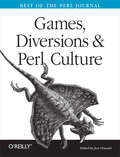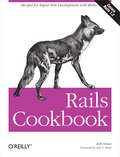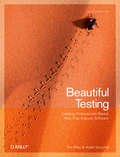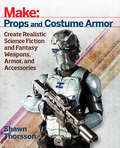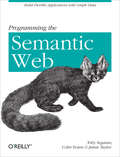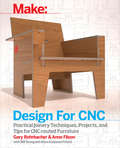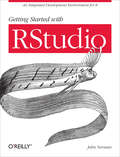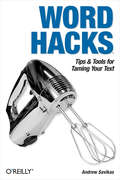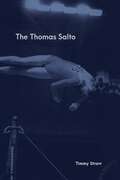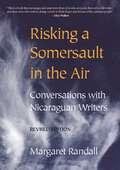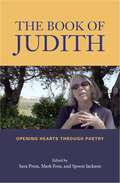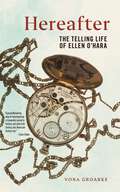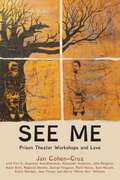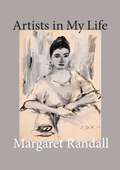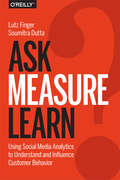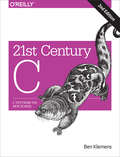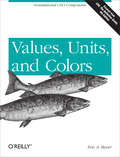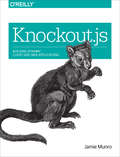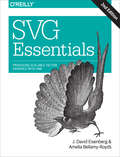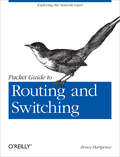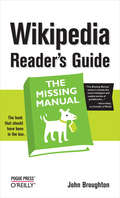- Table View
- List View
Games, Diversions & Perl Culture: Best of the Perl Journal (Best of the Perl Journal)
by Jon OrwantThe Perl Journal (TPJ) did something most print journals aspire to, but few succeed. Within a remarkable short time, TPJ acquired a cult-following and became the voice of the Perl community. Every serious Perl programmer subscribed to it, and every notable Perl guru jumped at the opportunity to write for it. Back issues were swapped like trading cards. No longer in print format, TPJ remains the quintessential spirit of Perl--a publication for and by Perl programmers who see fun and beauty in an admittedly quirky little language.Games, Diversions, and Perl Culture is the third volume of The Best of the Perl Journal, compiled and re-edited by the original editor and publisher of The Perl Journal, Jon Orwant. In this series, we've taken the very best (and still relevant) articles published in TPJ over its 5 years of publication and immortalized them into three volumes.The 47 articles included in this volume are simply some of the best Perl articles ever written on the subjects of games, diversions, and the unique culture of this close-knit community, by some of the best Perl authors and coders. Games, Diversions & Perl Culture focuses on entertaining topics that make Perl users such fanatics about the language. You'll find all of the playful features TPJ offered over the years, including the Obfuscated Perl Contests, Perl Quiz Shows, humor articles, and renowned one-line recipes. The book also contains a panoply of quirky applications of Perl, including genetic algorithms, home automation, music programming, and an entire section on natural language processing.This anthology is an unmatched compendium of Perl lore.
Rails Cookbook: Recipes for Rapid Web Development with Ruby
by Rob OrsiniRails Cookbook is packed with the solutions you need to be a proficient developer with Rails, the leading framework for building the new generation of Web 2.0 applications. Recipes range from the basics, like installing Rails and setting up your development environment, to the latest techniques, such as developing RESTful web services.With applications that are code light, feature-full and built to scale quickly, Rails has revolutionized web development. The Rails Cookbook addresses scores of real-world challenges; each one includes a tested solution, plus a discussion of how and why it works, so that you can adapt the techniques to similar situations. Topics include:Modeling data with the ActiveRecord librarySetting up views with ActionView and RHTML templatesBuilding your application's logic into ActionControllerTesting and debugging your Rails applicationBuilding responsive web applications using JavaScript and AjaxEnsuring that your application is security and performs wellDeploying your application with Mongrel and ApacheUsing Capistrano to automate deploymentUsing the many Rails pluginsWorking with graphicsWhether you're new to Rails or an experienced developer, you'll discover ways to test, debug and secure your applications, incorporate Ajax, use caching to improve performance, and put your application into production. Want to get ahead of the Web 2.0 curve? This valuable cookbook will save you hundreds of hours when developing applications with Rails.
Beautiful Testing: Leading Professionals Reveal How They Improve Software
by Adam Goucher Tim RileySuccessful software depends as much on scrupulous testing as it does on solid architecture or elegant code. But testing is not a routine process, it's a constant exploration of methods and an evolution of good ideas. Beautiful Testing offers 23 essays from 27 leading testers and developers that illustrate the qualities and techniques that make testing an art. Through personal anecdotes, you'll learn how each of these professionals developed beautiful ways of testing a wide range of products -- valuable knowledge that you can apply to your own projects.Here's a sample of what you'll find inside:Microsoft's Alan Page knows a lot about large-scale test automation, and shares some of his secrets on how to make it beautifulScott Barber explains why performance testing needs to be a collaborative process, rather than simply an exercise in measuring speedKaren Johnson describes how her professional experience intersected her personal life while testing medical softwareRex Black reveals how satisfying stakeholders for 25 years is a beautiful thingMathematician John D. Cook applies a classic definition of beauty, based on complexity and unity, to testing random number generatorsAll author royalties will be donated to the Nothing But Nets campaign to save lives by preventing malaria, a disease that kills millions of children in Africa each year.This book includes contributions from:Adam GoucherLinda WilkinsonRex BlackMartin SchröderClint TalbertScott BarberKamran KhanEmily ChenBrian NitzRemko TronçonAlan PageNeal NorwitzMichelle LevesqueJeffrey YasskinJohn D. CookMurali NandigamaKaren N. JohnsonChris McMahonJennitta AndreaLisa CrispinMatt HeusserAndreas ZellerDavid SchulerTomasz KojmAdam ChristianTim RileyIsaac Clerencia
Make: Create Realistic Science Fiction & Fantasy Weapons, Armor, and Accessories
by Shawn ThorssonHave you been trying to think of a way to conquer your local comic convention through cosplay? Do you gaze with envious eyes upon the fan-made suits of armored awesomeness strolling around every year on Halloween? Do you have a spot on your wall, bookshelf, or desk that desperately needs to be filled with a screen-accurate replica of your favorite science-fiction or fantasy weapon? If so, look no further. We've got just the book for you!In this book, master prop maker Shawn Thorsson uses his unique blend of humor and insight to turn years of painful experience into detailed explanations. He'll show you many of the tools, methods, and processes that you can use to create professional-looking science fiction and fantasy props and armor. The ultimate collision of creative imagination and practical maker skills, making props and costume armor involves sculpting, molding, casting, 3D printing, CNC fabrication, painting, and countless other techniques and technologies.In this book, you'll learn:Basic fabrication methods using inexpensive, commonly-available tools and materialsSimple, low-cost methods to make foam armor out of easy-to-find foam matsHow to use the popular Pepakura software to build 3D models with paperMultiple molding and casting techniquesHow to build a "vacuforming" machine to make armor from plastic sheet stockPainting and weathering techniques that will bring your props to lifeJust enough safety advice to keep you from losing body parts along the wayWhether you're just a beginner or a seasoned builder with countless projects behind you, this book is sure to be an invaluable addition to your workshop library.
Flash CS5: The Missing Manual (The\missing Manual Ser.)
by Chris GroverOnce you know how to use Flash, you can create everything from simple animations to high-end desktop applications, but it's a complex tool that can be difficult to master on your own-unless you have this Missing Manual. This book will help you learn all you need to know about Flash CS5 to create animations that bring your ideas to life.Learn animation basics. Find everything you need to know to get started with FlashMaster the Flash tools. Learn the animation and effects toolset, with clear explanations and hands-on examplesUse 3D effects. Rotate and put objects in motion in three dimensionsCreate lifelike motion. Use the IK Bones tool to simulate realistic body movements and other linked motionsSpeed up development. Use templates, code snippets, and motion presetsDesign applications. Get an intro to building full desktop applications with Flash and Adobe AIRCreate rich interactive animations. Dive into advanced interactivity with easy-to-learn ActionScript examples
Programming Internet Email: Mastering Internet Messaging Systems
by David WoodThe Internet's "killer app" is not the World Wide Web or Push technologies: it is humble electronic mail. More people use email than any other Internet application. As the number of email users swells, and as email takes on an ever greater role in personal and business communication, Internet mail protocols have become not just an enabling technology for messaging, but a programming interface on top of which core applications are built.Programming Internet Email unmasks the Internet Mail System and shows how a loose federation of connected networks have combined to form the world's largest and most heavily trafficked message system.Programming Internet Email tames the Internet's most popular messaging service. For programmers building applications on top of email capabilities, and power users trying to get under the hood of their own email systems, Programming Internet Email stands out as an essential guide and reference book. In typical O'Reilly fashion,Programming Internet Email covers the topic with nineteen tightly written chapters and five useful appendixes.Following a thorough introduction to the Internet Mail System, the book is divided into five parts:Part I covers email formats, from basic text messages to the guts of MIME. Secure email message formats (OpenPGP and S/MIME), mailbox formats and other commonly used formats are detailed in this reference section.Part II describes Internet email protocols: SMTP and ESMTP, POP3 and IMAP4. Each protocol is covered in detail to expose the Internet Mail System's inner workings.Part III provides a solid API reference for programmers working in Perl and Java. Class references are given for commonly used Perl modules that relate to email and the Java Mail API.Part IV provides clear and concise examples of how to incorporate email capabilities into your applications. Examples are given in both Perl and Java.Part V covers the future of email on the Internet. Means and methods for controlling spam email and newly proposed Internet mail protocols are discussed.Appendixes to Programming Internet Email provide a host of explanatory information and useful references for the programmer and avid user alike, including a comprehensive list of Internet RFCs relating to email, MIME types and a list of email related URLs.Programming Internet Email will answer all of your questions about mail and extend your abilities into this most popular messaging frontier.
Programming the Semantic Web: Build Flexible Applications with Graph Data
by Toby Segaran Colin Evans Jamie TaylorWith this book, the promise of the Semantic Web -- in which machines can find, share, and combine data on the Web -- is not just a technical possibility, but a practical reality Programming the Semantic Web demonstrates several ways to implement semantic web applications, using current and emerging standards and technologies. You'll learn how to incorporate existing data sources into semantically aware applications and publish rich semantic data.Each chapter walks you through a single piece of semantic technology and explains how you can use it to solve real problems. Whether you're writing a simple mashup or maintaining a high-performance enterprise solution,Programming the Semantic Web provides a standard, flexible approach for integrating and future-proofing systems and data.This book will help you:Learn how the Semantic Web allows new and unexpected uses of data to emergeUnderstand how semantic technologies promote data portability with a simple, abstract model for knowledge representationBecome familiar with semantic standards, such as the Resource Description Framework (RDF) and the Web Ontology Language (OWL)Make use of semantic programming techniques to both enrich and simplify current web applications
Design for CNC: Furniture Projects and Fabrication Technique
by Anna Kaziunas France Bill Young Gary Rohrbacher Anne FilsonDesign, DIY, and computer-controlled fabrication are a powerful combination for making high-quality customized things. Written by the founders of the architecture, design, and research firm Filson and Rohrbacher, this book takes you through the basics of CNC fabrication, the design process, production, and construction of your own furniture designs. Through their AtFAB series of projects, accompanied by an overview of digital techniques and design thinking, this book introduces the knowledge and skills that you'll find widely applicable across all kinds of CNC projects. Not only will you learn how to design, fabricate, and assemble a wide range of projects, you'll have some great furniture to show for it! While 3D printing has been grabbing headlines, high school, college, library, and other public makerspaces have been making things with CNC machines. With a CNC router, you can cut parts from strong, tactile, durable materials like wood. Once you have your design and material, you can set up your job and let it run. When it's done, you can put the project together for an heirloom of your own. While 3D printing can make exciting things with complex designs, CNCs are the digital workhorses that produce large-scale, long-lasting objects.
Getting Started with RStudio: An Integrated Development Environment for R
by John VerzaniDive into the RStudio Integrated Development Environment (IDE) for using and programming R, the popular open source software for statistical computing and graphics. This concise book provides new and experienced users with an overview of RStudio, as well as hands-on instructions for analyzing data, generating reports, and developing R software packages.The open source RStudio IDE brings many powerful coding tools together into an intuitive, easy-to-learn interface. With this guide, you’ll learn how to use its main components—including the console, source code editor, and data viewer—through descriptions and case studies. Getting Started with RStudio serves as both a reference and introduction to this unique IDE.Use RStudio to provide enhanced support for interactive R sessionsClean and format raw data quickly with several RStudio componentsEdit R commands with RStudio’s code editor, and combine them into functionsEasily locate and use more than 3,000 add-on packages in R’s CRAN serviceDevelop and document your own R packages with the code editor and related componentsCreate one-click PDF reports in RStudio with a mix of text and R output
Word Hacks: Tips & Tools for Taming Your Text (Hacks)
by Andrew SavikasAs one of the applications in Microsoft Office, Word is the dominant word-processing program for both Windows and Mac users. Millions of people around the globe use it. But many, if not most, of them barely skim the surface of what is possible with Microsoft Word. Seduced by the application's supposed simplicity, they settle for just what's obvious--even if it doesn't satisfy their wants and needs. They may curse the wretched Bullets and Numbering buttons multiple times a day or take hours to change the font size of every heading in a lengthy report, yet they're reluctant to dig deeper to take advantage of Word's immense capabilities and limitless customization tools.Let Word Hacks be your shovel. Let it carve your way into Word and make this most popular and powerful application do precisely what you want it to do. Filled with insider tips, tools, tricks, and hacks, this book will turn you into the power user you always wanted to be. Far beyond a tutorial, Word Hacks assumes you have a solid working knowledge of the application and focuses on showing you exactly how to accomplish your pressing tasks, address your frequent annoyances, and solve even your most complex problems.Author Andrew Savikas examines Word's advanced (and often hidden) features and delivers clever, time-saving hacks on taming document bloat, customization, complex search and replace, Tables of Contents and indexes, importing and exporting files, tables and comments, and even using Google as a dictionary! With him as your guide, you'll soon be understanding--and hacking--Word in ways you never thought possible.Covering Word 2000, 2002 and Word 2003, Word Hacks exposes the inner workings of Word and releases your inner hacker; with it, you will be equipped to take advantage of the application s staggering array of advanced features that were once found only in page layout programs and graphics software and turning Word into your personal productivity powerhouse.
The Thomas Salto
by Timmy StrawThe Thomas Salto takes its name from a difficult and dangerous move in gymnastics, a leaping triple flip popularized during the last years of the Cold War. Both in its Reagan-grained historicity, and in the human body that bears the leap’s flight and risk, the Thomas salto is a kinetic figure for these poems’ action in time and space. They shadow the AIDS epidemic, the war on drugs, the US proxy wars in Central America, Afghanistan, and the Middle East, the Soviet collapse—not as history but as the camouflage-pattern of “then” and “to come” which form the flickering and very real habitus of the present.
Violence Never Heals: The Lifelong Effects of Intimate Partner Violence for Immigrant Women (Anthropologies of American Medicine: Culture, Power, and Practice)
by Allison BloomExplores experiences with disability and aging for immigrant survivors of domestic violence across thelife courseAcross the United States, one in three women experiences violence in their intimate relationships. More resources are now being devoted to providing these women with immediate care; but what happens to survivors, especially those from marginalized communities, as they grow older and grapple with the long-term effects? In Violence Never Heals, Allison Bloom presents a life-course perspective on the disabling experience of violence in Latina immigrant communities.Drawing on extensive ethnographic fieldwork performed in a Latina program at an Intimate Partner Violence (IPV) crisis center, Bloom offers insights into the long-term effects of systemic and gender-based violence, revealing that these experiences become subtly disabling long before old age. Drawing from her own background as a practitioner, Bloom further details how current IPV services fail to acknowledge and accommodate such effects, in large part because of their disproportionate focus on younger survivors and the particular development of the domestic violence services field. She offers both scholars and practitioners concrete strategies for how they can alter their approaches to better treat and mitigate the lifelong effects of domestic violence. Violence Never Heals addresses a glaring omission in IPV scholarship, providing both an aging-focused perspective on IPV as well as laying out concrete steps for how to implement this perspective in pursuit of more comprehensive treatment.
Risking a Somersault in the Air: Conversations with Nicaraguan Writers (Revised edition)
by Margaret RandallFirst revised edition of interviews with 14 prominent activists whose writings influenced the 1979 Nicaraguan revolution and help us understand present-day NicaraguaMargaret Randall presents a dynamic collection of personal interviews with Nicaragua's most important writer-revolutionaries who played major roles in the 1979 revolution and the subsequent reconstruction. This revised first edition includes a new preface and additional notes that frame the narrative in high relevance to the present day. The featured writer-activists speak of their work and practical tasks in constructing a new society. Among the writers included are Gioconda Belli, Tomás Borge, Omar Cabezas, Ernesto Cardenal, Vidaluz Menéses, Julio Valle-Castillo, and Daisy Zamora. The work also features 50 evocative photographs from the era by Margaret Randall.
The Book of Judith: Opening Hearts Through Poetry
by Sara Press, Mark Foss and Spoon JacksonAn homage to the life of poet, writer, and teaching artist Judith Tannenbaum and her impact on incarcerated and marginalized students.The Book of Judith honors Judith Tannenbaum but also reflects, through both form and content, on the complexities of seeing both the parts and the whole. The book presents different aspects of Judith—poet, teaching artist, friend, mentor, colleague—through a collection of original poetry, prose, essay, illustration, and fiction from 33 contributors. In so doing, it echoes her own determination to perceive contradiction without judgment. For the next generation of teaching artists in Corrections and elsewhere, the book serves as an inspiration on the qualities needed to survive and thrive in a multi-faceted, ever-changing environment.The book is divided into four sections, separated by riveting black and white pencil drawings inspired by the lives of those serving life in prison without possibility of parole. In Unfinished Conversations, contributors share their bond with Judith Tannenbaum through prose and excerpts from letters both real and imagined. In the second section, After December, poets reflect on the life, artistry, and legacy of Judith. The third section, Looking and Listening, focuses on the truth-seeking qualities that Judith brought to her work. The fourth section, Legacy, features work from winners of an award and a fellowship bestowed in her name.
Hereafter: The Telling Life of Ellen O'Hara (The Glucksman Irish Diaspora Series #6)
by Vona GroarkeWinner of the 2024 Michel Déon Prize for Non-FictionA lyrical portrait of a young Irish woman reinventing herself at the turn of the twentieth century in AmericaEllen O’Hara was a young immigrant from Ireland at the end of the nineteenth century who, with courage and resilience, made a life for herself in New York while financially supporting those at home. Hereafter is her story, told by Vona Groarke, her descendant, in a beautiful blend of poetry, prose, and history. In July 1882, Ellen O’Hara stepped off a ship from the West of Ireland to begin a new life in New York. What she encountered was a world of casual racial prejudice that characterized her as ignorant, dirty, and feckless, the butt of many jokes. From the slim range of jobs available to her she, like, many of her kind, found a position as a domestic servant, working long hours and living in to save on rent and keep. After an unfortunate marriage, Ellen determined to win financial security on her own, and eventually opened a boarding house where her two children were able to rejoin her. Vona Groarke builds this story from historical fact, drawing from various archives for evidence of Ellen. However, she also considers why lives such as Ellen’s seem to leave such a light trace in such records and fills in the gaps with memory and empathetic projection. Ellen—scrappy, skeptical, and straight-talking—is the heroine of Hereafter, whose resilience animates the story and whose voice shines through with vivid clarity. Hereafter is both a compelling account of an incredible figure and a reflection on how one woman’s story can speak for more than one life.
See Me: Prison Theater Workshops and Love
by Jan Cohen-CruzEncounters, transformations, and reflections from in-prison and post-release theater workshopsSee Me is a collection of intimate dialogues about collective experiences in the context of prison theater workshops. Each essay is a collaboration between two or three people who connected profoundly in the temporary community that a workshop can create. Part I is an exchange grounded in the prison theater workshop between the author and one of the incarcerated participants. They alternately tell the story of what they found in the workshop, each other, the future they imagined together, and the social turmoil and utopian aspirations of the times. Part II consists of essays jointly written by eight other people impacted by close relationships spawned in diverse in-prison and re-entry theater workshops.
The Civil War Diary of Emma Mordecai (Goldstein-Goren Series in American Jewish History #25)
by Melissa R. Klapper Dianne AshtonA vivid look at the wartime experiences of a Jewish woman in the Confederate SouthEmma Mordecai lived an unusual life. She was Jewish when Jews comprised less than 1 percent of the population of the Old South, and unmarried in a culture that offered women few options other than marriage. She was American born when most American Jews were immigrants. She affirmed and maintained her dedication to Jewish religious practice and Jewish faith while many family members embraced Christianity. Yet she also lived well within the social parameters established for Southern white women, espoused Southern values, and owned enslaved African Americans.The Civil War Diary of Emma Mordecai is one of the few surviving Civil War diaries by a Jewish woman in the antebellum South. It charts her daily life and her evolving perspective on Confederate nationalism and Southern identity, Jewishness, women’s roles in wartime, gendered domestic roles in slave-owning households, and the centrality of family relationships. While never losing sight of the racist social and political structures that shaped Emma Mordecai’s world, the book chronicles her experiences with dislocation and the loss of her home.Bringing to life the hospital visits, food shortages, local sociability, Jewish observances, sounds and sights of nearby battles, and the very personal ramifications of emancipation and its aftermath for her household and family, The Civil War Diary of Emma Mordecai offers a valuable and distinct look at a unique historical figure from the waning years of the Civil War South.
Artists in My Life
by Margaret RandallMargaret Randall reveals personal stories and profound insights about the artists who most influenced her life.Artists in My Life is a collection of intimate and conversational accounts of the visual artists that have impacted the renowned poet activist Margaret Randall on her own journey as an artist. Randall writes of each relationship through multiple lenses: as makers of art, social commentators, women in a world dominated by male values, and in solitude or collaboration with communities and the larger artistic arena. Each story offers insight into the artist’s life and work, and analyses the impact it had on Randall’s own work and its impact on the larger art community. The work strives to answer bigger questions about visual art as a whole and its lasting political influence on the world stage. Randalls describes her motivations: ”I go beneath the surface, asking questions and telling stories. I have wanted to answer questions such as: Why is it that visual art—drawing, painting, sculpture, photography, architecture—grabs me and, in particular instances, feels as if it changes me at the molecular level? How do art and memory interact? How do reason and intuition come together in art? Do women and men make art differently? Does great art change the viewer? Does it change the artist? How does art travel through time?”
Ask, Measure, Learn: Using Social Media Analytics to Understand and Influence Customer Behavior
by Lutz Finger Soumitra DuttaYou can measure practically anything in the age of social media, but if you don’t know what you’re looking for, collecting mountains of data won’t yield a grain of insight. This non-technical guide shows you how to extract significant business value from big data with Ask-Measure-Learn, a system that helps you ask the right questions, measure the right data, and then learn from the results.Authors Lutz Finger and Soumitra Dutta originally devised this system to help governments and NGOs sift through volumes of data. With this book, these two experts provide business managers and analysts with a high-level overview of the Ask-Measure-Learn system, and demonstrate specific ways to apply social media analytics to marketing, sales, public relations, and customer management, using examples and case studies.
21st Century C: C Tips from the New School
by Ben KlemensThrow out your old ideas about C and get to know a programming language that’s substantially outgrown its origins. With this revised edition of 21st Century C, you’ll discover up-to-date techniques missing from other C tutorials, whether you’re new to the language or just getting reacquainted.C isn’t just the foundation of modern programming languages; it is a modern language, ideal for writing efficient, state-of-the-art applications. Get past idioms that made sense on mainframes and learn the tools you need to work with this evolved and aggressively simple language. No matter what programming language you currently favor, you’ll quickly see that 21st century C rocks.Set up a C programming environment with shell facilities, makefiles, text editors, debuggers, and memory checkersUse Autotools, C’s de facto cross-platform package managerLearn about the problematic C concepts too useful to discardSolve C’s string-building problems with C-standard functionsUse modern syntactic features for functions that take structured inputsBuild high-level, object-based libraries and programsPerform advanced math, talk to internet servers, and run databases with existing C librariesThis edition also includes new material on concurrent threads, virtual tables, C99 numeric types, and other features.
Values, Units, and Colors: Foundational CSS3 Components
by Eric A. MeyerNearly everything you do with CSS involves units for determining the look and formatting of your web page elements. With this concise guide, you’ll learn how to work with an array of units—including measurements and keywords—that help you define color, text, distance between elements, location of external files, and other values.This book contains chapters from the upcoming fourth edition of CSS: The Definitive Guide. When you purchase either the print or the ebook edition of Values, Units, and Colors, you’ll receive a significant discount on the entire Definitive Guide when it’s released. Why wait when you can learn how to use units and other key CSS3 features right away?Use RGB or HSL values to mix your own colors, and designate the degree of opacityLearn how to apply global keywords introduced in CSS3Use string values to wrap a sequence of text characters in quotesDescribe margins, letter spacing, and other properties, with either fixed or relative length unitsUnderstand how number, integer, and percentage values differExplore CSS3 unit types for describing display resolutionUse time values for transitions and animations
Knockout.js: Building Dynamic Client-Side Web Applications
by Jamie MunroUse Knockout.js to design and build dynamic client-side web applications that are extremely responsive and easy to maintain. This example-driven book shows you how to use this lightweight JavaScript framework and its Model-View-ViewModel (MVVM) pattern. You’ll learn how to build your own data bindings, extend the framework with reusable functions, and work with a server to enhance your client-side application with persistence. In the final chapter, you’ll build a shopping cart to see how everything fits together.If you’re a web developer with experience in JavaScript, HTML, and CSS, you’re ready for Knockout.Learn how to create a ViewModelBind HTML data and attributes, and CSS classes and stylesUnderstand data binding in Knockout’s context hierarchyUse properties that change dynamically through user interactionWork with forms by using several different bindingsBind multiple ViewModels on a single pageExtend or attach custom functions to observablesPerform server-side interactions with jQueryMap a JavaScript object or apply JSON data to a new object
SVG Essentials: Producing Scalable Vector Graphics with XML
by J. David Eisenberg Amelia Bellamy-RoydsLearn the essentials of Scalable Vector Graphics, the mark-up language used by most vector drawing programs and interactive web graphics tools. SVG Essentials takes you through SVG’s capabilities, beginning with simple line drawings and moving through complicated features such as filters, transformations, gradients, and patterns.This thoroughly updated edition includes expanded coverage of animation, interactive graphics, and scripting SVG. Interactive examples online make it easy for you to experiment with SVG features in your web browser. Geared toward experienced designers, this book also includes appendices that explain basic concepts such as XML markup and CSS styling, so even if you have no web design experience, you can start learning SVG.Create and style graphics to match your web design in a way that looks great when printed or displayed on high-resolution screensMake your charts and decorative headings accessible to search engines and assistive technologiesAdd artistic effects to your graphics, text, and photographs using SVG masks, filters, and transformationsAnimate graphics with SVG markup, or add interactivity with CSS and JavaScriptCreate SVG from existing vector data or XML data, using programming languages and XSLT
Packet Guide to Routing and Switching: Exploring the Network Layer
by Bruce HartpenceGo beyond layer 2 broadcast domains with this in-depth tour of advanced link and internetwork layer protocols, and learn how they enable you to expand to larger topologies. An ideal follow-up to Packet Guide to Core Network Protocols, this concise guide dissects several of these protocols to explain their structure and operation.This isn’t a book on packet theory. Author Bruce Hartpence built topologies in a lab as he wrote this guide, and each chapter includes several packet captures. You’ll learn about protocol classification, static vs. dynamic topologies, and reasons for installing a particular route.This guide covers:Host routing—Process a routing table and learn how traffic starts out across a networkStatic routing—Build router routing tables and understand how forwarding decisions are made and processedSpanning Tree Protocol—Learn how this protocol is an integral part of every network containing switchesVirtual Local Area Networks—Use VLANs to address the limitations of layer 2 networksTrunking—Get an indepth look at VLAN tagging and the 802.1Q protocolRouting Information Protocol—Understand how this distance vector protocol works in small, modern communication networksOpen Shortest Path First—Discover why convergence times of OSPF and other link state protocols are improved over distance vectors
Wikipedia Reader's Guide: The Missing Manual
by John BroughtonYou don't have to understand how to edit Wikipedia in order to find the information you need and join the conversation. This booklet gives you just what you need to know in friendly, concise form so you can research any subject without getting lost in Wikipedia's labyrinth. With it, you'll be able to unlock the mysteries of the many links on every Wikipedia page and the sometimes cryptic buzzwords you see on Talk pages.And, while this booklet focuses on Wikipedia readers, it also includes a tutorial for first-time editors and explains Wikipedia's editing tools. You'll find valuable advice on how to alert editors to flaws in articles and how to contribute to Talk pages without getting caught up in pointless disputes.The author of Wikipedia Reader's Guide: The Missing Manual has edited more than 15,000 Wikipedia articles, and has written a comprehensive index to Wikipedia for editors to use in their daily work. His knowledge of Wikipedia is limitless and his passion is contagious. With this guide, you'll catch on quickly.
